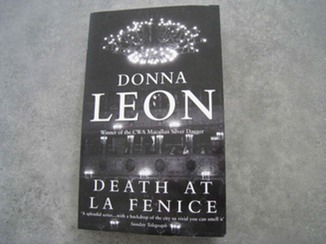Friday, 15 June 2012
 The fact that I’ve enjoyed whatever Donna Leon title I’ve picked up probably means she was a prime contender for reread the series from the start status, but if I hadn’t chanced upon Death at La Fenice in the el cheapo bins at Townsville’s Target that prospect would probably be something for the distant future.
The fact that I’ve enjoyed whatever Donna Leon title I’ve picked up probably means she was a prime contender for reread the series from the start status, but if I hadn’t chanced upon Death at La Fenice in the el cheapo bins at Townsville’s Target that prospect would probably be something for the distant future.
As it turns out, now that I’ve got, and have read, the first title, there have been orders for the next couple (currently substantially discounted to the point where there’s not that much difference between tracking them down at Fishpond and scouring the el cheapo bins for the little devils.
So, One down, Two and Three ordered, a couple more on the shelves, two already reviewed on the website, what’s the G.O. here?
Well, for a start, it has been a long time since I found a first title in a seres that’s as fully formed as Death at La Fenice. Usually you start reading a series and things gradually fall in place as the author comes to terms with the key characters and the setting, but here, most of the elements that run through the series are firmly in place.
Admittedly, some of the characters who become key players in later titles have yet to make an appearance, the key one being Signora Elettra, computer wizard and secretary of Commissario Brunetti’s boss, who wouldn’t have been able to work her magic when Death was written because 1992 (the year the book was published) was comfortably before the development of the World Wide Web she trawls so efficiently.
But, effectively, from the get go we’ve got Guido Brunetti, devoted family man whose in-laws come from one of Venice’s foremost aristocratic families. He’s not exactly thrilled about this. Despite the fact he’s been married for seventeen years he isn’t sure of how to address the father-in-law and isn’t comfortable in their presence.
His wife and children are, from the start, much the way they continue to be through twenty years and twenty-one titles.
Paola Brunetti, University lecturer in English literature, has most of the mannerisms that continue through the series in place from the start, though her reputation in the kitchen is still to come to the fore and the two teenage kids age a little over the series, but it’s not as if Brunetti’s about to become a grandfather any time soon.
Another key piece who falls into place almost fully formed is Brunetti’s superior, Vice-Questore Giuseppi Patta, the vain and almost insufferably pretentious man who’s not very bright. While he’ll suck up to the rich and influential he doesn’t seem to have bothered to dig around enough to learn Brunetti’s father-in-law has two doges on his mother’s side of the family or maybe he’s too busy associating himself with politicians and the like to be admitted to the patrician circles where the really influential Venetians are found.
In any case, news that world famous conductor Helmut Wellauer has been found dead at the end of the intermission between Acts Two and Three of Verdi’s La Traviata in La Fenice Opera House is certain to be greeted with alarm among Patta’s superiors so he’ll inevitably be throwing his weight around in the quest for a quick solution to a death that casts the city in a very bad light, isn’t he?
Brunetti, on the other hand, goes about his business systematically, using clever mental stratagems to avoid excessive angst prompted by Patta’s posturing and tackling the suspects diplomatically as he comes to realise that the key to the mystery lies somewhere in Wellauer’s personality and quite possibly in the long distant past.
From the moment the body is discovered there’s no doubt about how he died. There’s a smell of bitter almonds in the dressing room, to the extent that the doctor who’s called to the scene and Brunetti both know there was cyanide in the maestro’s coffee even though they’ve only read about that sort of thing in detective stories.